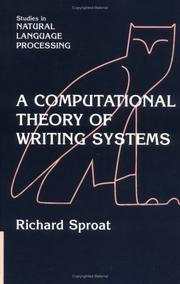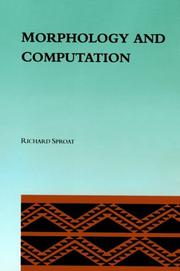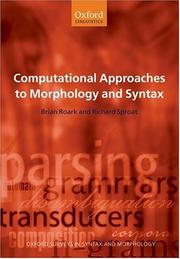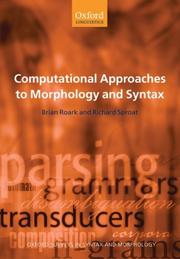| Listing 1 - 10 of 16 | << page >> |
Sort by
|

ISBN: 0521663407 9780521663403 Year: 2000 Publisher: Cambridge Cambridge University Press
Abstract | Keywords | Export | Availability | Bookmark
 Loading...
Loading...Choose an application
- Reference Manager
- EndNote
- RefWorks (Direct export to RefWorks)
Mathematical linguistics --- Orthography --- Written communication --- Data processing --- Written communication - Data processing
Book
ISBN: 9780199549382 0199549389 Year: 2010 Publisher: New York Oxford university press
Abstract | Keywords | Export | Availability | Bookmark
 Loading...
Loading...Choose an application
- Reference Manager
- EndNote
- RefWorks (Direct export to RefWorks)
Computational linguistics. --- Sociolinguistics. --- Mathematical linguistics --- Sociolinguistics --- Computational linguistics --- Language and languages --- Language and society --- Society and language --- Sociology of language --- Language and culture --- Linguistics --- Sociology --- Integrational linguistics (Oxford school) --- Automatic language processing --- Language data processing --- Natural language processing (Linguistics) --- Applied linguistics --- Cross-language information retrieval --- Multilingual computing --- Social aspects --- Sociological aspects --- Data processing
Book
ISBN: 3031268091 3031268083 Year: 2023 Publisher: Cham : Springer Nature Switzerland : Imprint: Springer,
Abstract | Keywords | Export | Availability | Bookmark
 Loading...
Loading...Choose an application
- Reference Manager
- EndNote
- RefWorks (Direct export to RefWorks)
For millennia humans have used visible marks to communicate information. Modern examples of conventional graphical symbols include written language, and non-linguistic symbol systems such as mathematical symbology or traffic signs. The latter kinds of symbols convey information without reference to language. This book presents the first systematic study of graphical symbol systems, including a history of graphical symbols from the Paleolithic onwards, a taxonomy of non-linguistic systems – systems that are not tied to spoken language – and a survey of more than 25 such systems. One important feature of many non-linguistic systems is that, as in written language, symbols may be combined into complex “messages” if the information the system represents is itself complex. To illustrate, the author presents an in-depth comparison of two systems that had very similar functions, but very different structure: European heraldry and Japanese kamon. Writing first appeared in Mesopotamia about 5,000 years ago and is believed to have evolved from a previous non-linguistic accounting system. The exact mechanism is unknown, but crucial was the discovery that symbols can represent the sounds of words, not just the meanings. The book presents a novel neurologically-inspired hypothesis that writing evolved in an institutional context in which symbols were “dictated”, thus driving an association between symbol and sound, and provides a computational simulation to support this hypothesis. The author further discusses some common fallacies about writing and non-linguistic systems, and how these relate to widely cited claims about statistical “evidence” for one or another system being writing. The book ends with some thoughts about the future of graphical symbol systems. The intended audience includes students, researchers, lecturers, professionals and scientists from fields like Natural Language Processing, Machine Learning, Archaeology and Semiotics, as well as general readers interested in language and/or writing systems and symbol systems. Richard Sproat is a Research Scientist at Google working on Deep Learning. He has a long-standing interest in writing systems and other graphical symbol systems.
Natural language processing (Computer science). --- Machine learning. --- Digital humanities. --- Social sciences --- Computational linguistics. --- Computer simulation. --- Natural Language Processing (NLP). --- Machine Learning. --- Digital Humanities. --- Computer Application in Social and Behavioral Sciences. --- Computational Linguistics. --- Computer Modelling. --- Data processing. --- Learning, Machine --- Artificial intelligence --- Machine theory --- NLP (Computer science) --- Electronic data processing --- Human-computer interaction --- Semantic computing --- Computer modeling --- Computer models --- Modeling, Computer --- Models, Computer --- Simulation, Computer --- Electromechanical analogies --- Mathematical models --- Simulation methods --- Model-integrated computing --- Automatic language processing --- Language and languages --- Language data processing --- Linguistics --- Natural language processing (Linguistics) --- Applied linguistics --- Cross-language information retrieval --- Mathematical linguistics --- Multilingual computing --- Humanities --- Data processing

ISBN: 0262193140 0262284170 0262527022 0585038341 9780262193146 9780262284172 9780585038346 9780262527026 Year: 1992 Publisher: Cambridge, Mass. MIT Press
Abstract | Keywords | Export | Availability | Bookmark
 Loading...
Loading...Choose an application
- Reference Manager
- EndNote
- RefWorks (Direct export to RefWorks)
"This book provides the first broad yet thorough coverage of issues in morphological theory. It includes a wide array of techniques and systems in computational morphology (including discussion of their limitations), and describes some unusual applications. Sproat motivates the study of computational morphology by arguing that a computational natural language system, such as a parser or a generator, must incorporate a model of morphology. He discusses a range of applications for programs with knowledge of morphology, some of which are not generally found in the literature. Sproat then provides an overview of some of the basic descriptive facts about morphology and issues in theoretical morphology and (lexical) phonology, as well as psycholinguistic evidence for human processing of morphological structure. He take up the basic techniques that have been proposed for doing morphological processing and discusses at length various systems (such as DECOMP and KIMMO) that incorporate part or all of those techniques, pointing out the inadequacies of such systems from both a descriptive and a computational point of view. He concludes by touching on interesting peripheral areas such as the analysis of complex nominals in English, and on the main contributions of Rumelhart and McClelland's connectionism to the computational analysis of words."
Mathematical linguistics --- Grammar --- Grammar, Comparative and general --- -Morphology --- Data processing --- Morphology --- -Grammar, Comparative and general --- -Comparative grammar --- Grammar, Philosophical --- Grammar, Universal --- Language and languages --- Philosophical grammar --- Linguistics --- Philology --- -Data processing --- Grammar, Comparative --- Languages & Literatures --- Philology & Linguistics --- Data processing. --- -Mathematical linguistics --- Comparative grammar --- Morphology (Linguistics) --- Morphology&delete& --- -Grammar --- Morphology. --- Morphology (Grammar) --- LINGUISTICS & LANGUAGE/General --- Grammar, Comparative and general Morphology

ISBN: 9780199274789 9780199274772 Year: 2007 Publisher: New York Oxford university press
Abstract | Keywords | Export | Availability | Bookmark
 Loading...
Loading...Choose an application
- Reference Manager
- EndNote
- RefWorks (Direct export to RefWorks)
Artificial intelligence. Robotics. Simulation. Graphics --- Grammar --- Mathematical linguistics --- Computational linguistics --- Grammar, Comparative and general --- Comparative grammar --- Grammar, Philosophical --- Grammar, Universal --- Language and languages --- Philosophical grammar --- Linguistics --- Philology --- Automatic language processing --- Language data processing --- Natural language processing (Linguistics) --- Applied linguistics --- Cross-language information retrieval --- Multilingual computing --- Morphology&delete& --- Data processing --- Syntax&delete& --- Grammar, Comparative --- Morphology --- Syntax
Book
ISBN: 3031001907 3031010515 3031021797 Year: 2021 Publisher: Springer
Abstract | Keywords | Export | Availability | Bookmark
 Loading...
Loading...Choose an application
- Reference Manager
- EndNote
- RefWorks (Direct export to RefWorks)
Book
ISBN: 9780191576386 0191576387 Year: 2010 Publisher: Oxford ; New York : Oxford University Press,
Abstract | Keywords | Export | Availability | Bookmark
 Loading...
Loading...Choose an application
- Reference Manager
- EndNote
- RefWorks (Direct export to RefWorks)
This book traces the history of language technology from writing - the first technology specifically designed for language - to digital speech and other contemporary language systems. The book describes the social impact of technological developments over five millennia, and addresses topics such as the ways in which literacy has influenced cognitive and scientific development; the social impact of modern speech technology; the influence of various printingtechnologies; the uses and limitations of machine translation; how far mass information access is a means for exploitation or enlightenment; the deciphering of ancient scripts; and technical aids for people with language disabilities.Richard Sproat writes in a clear, readable style, introducing linguistic and other scientific concepts as they are needed. His book offers fascinating reading for everyone interested in how language and technology have shaped and continue to shape our day-to-day lives.
Computational Linguistics --- Sociolinguistics --- Computers --- Language Arts & Disciplines --- Computational linguistics. --- Sociolinguistics.
Book
Year: 1992 Publisher: Cambridge (MA) ; London : M.I.T. Press,
Abstract | Keywords | Export | Availability | Bookmark
 Loading...
Loading...Choose an application
- Reference Manager
- EndNote
- RefWorks (Direct export to RefWorks)
GRAMMAR, COMPARATIVE AND GENERAL --- MORPHOLOGY --- GRAMMAR, COMPARATIVE AND GENERAL --- MORPHOLOGY

ISBN: 9786611164607 1281164607 019153451X 1435610075 9780191534515 661116460X 0199274770 0199274789 9780199274789 9780199274772 1383041792 Year: 2007 Publisher: Oxford New York Oxford University Press
Abstract | Keywords | Export | Availability | Bookmark
 Loading...
Loading...Choose an application
- Reference Manager
- EndNote
- RefWorks (Direct export to RefWorks)
The authors provide a critical and practical guide to computational techniques for handling morphological and syntactic phenomena, showing how these techniques have been used and modified in practice.
Computational linguistics. --- Grammar, Comparative and general --- Comparative grammar --- Grammar --- Grammar, Philosophical --- Grammar, Universal --- Language and languages --- Philosophical grammar --- Linguistics --- Philology --- Automatic language processing --- Language data processing --- Natural language processing (Linguistics) --- Applied linguistics --- Cross-language information retrieval --- Mathematical linguistics --- Multilingual computing --- Morphology --- Data processing. --- Syntax --- Grammar, Comparative --- Data processing
Multi
ISBN: 9783031268090 9783031268083 9783031268106 9783031268113 3031268091 Year: 2023 Publisher: Cham Springer Nature Switzerland :Imprint: Springer
Abstract | Keywords | Export | Availability | Bookmark
 Loading...
Loading...Choose an application
- Reference Manager
- EndNote
- RefWorks (Direct export to RefWorks)
For millennia humans have used visible marks to communicate information. Modern examples of conventional graphical symbols include written language, and non-linguistic symbol systems such as mathematical symbology or traffic signs. The latter kinds of symbols convey information without reference to language. This book presents the first systematic study of graphical symbol systems, including a history of graphical symbols from the Paleolithic onwards, a taxonomy of non-linguistic systems – systems that are not tied to spoken language – and a survey of more than 25 such systems. One important feature of many non-linguistic systems is that, as in written language, symbols may be combined into complex “messages” if the information the system represents is itself complex. To illustrate, the author presents an in-depth comparison of two systems that had very similar functions, but very different structure: European heraldry and Japanese kamon. Writing first appeared in Mesopotamia about 5,000 years ago and is believed to have evolved from a previous non-linguistic accounting system. The exact mechanism is unknown, but crucial was the discovery that symbols can represent the sounds of words, not just the meanings. The book presents a novel neurologically-inspired hypothesis that writing evolved in an institutional context in which symbols were “dictated”, thus driving an association between symbol and sound, and provides a computational simulation to support this hypothesis. The author further discusses some common fallacies about writing and non-linguistic systems, and how these relate to widely cited claims about statistical “evidence” for one or another system being writing. The book ends with some thoughts about the future of graphical symbol systems. The intended audience includes students, researchers, lecturers, professionals and scientists from fields like Natural Language Processing, Machine Learning, Archaeology and Semiotics, as well as general readers interested in language and/or writing systems and symbol systems. Richard Sproat is a Research Scientist at Google working on Deep Learning. He has a long-standing interest in writing systems and other graphical symbol systems.
Human sciences --- Social sciences (general) --- Demography --- Programming --- Computer architecture. Operating systems --- Information systems --- Artificial intelligence. Robotics. Simulation. Graphics --- Computer. Automation --- Mathematical linguistics --- NLP (neurolinguïstisch programmeren) --- spraaktechnologie --- analytische chemie --- sociale media --- biochemie --- informatica --- sociale wetenschappen --- mineralen (chemie) --- programmeren (informatica) --- mijnbouw --- Natural language processing (Computer science). --- Machine learning. --- Digital humanities. --- Social sciences --- Computational linguistics. --- Computer simulation. --- Natural Language Processing (NLP). --- Machine Learning. --- Digital Humanities. --- Computer Application in Social and Behavioral Sciences. --- Computational Linguistics. --- Computer Modelling. --- Data processing.
| Listing 1 - 10 of 16 | << page >> |
Sort by
|

 Search
Search Feedback
Feedback About UniCat
About UniCat  Help
Help News
News